
* Although Europeans had invented the helicopter, the devastation of World War II ensured that it would be Americans -- most significantly an immigrant named Igor Ivanovich Sikorsky -- who would actually be the first to put a true helicopter into full production. The first production helicopters would be of marginal usefulness, but they would point the way to bigger and better things.
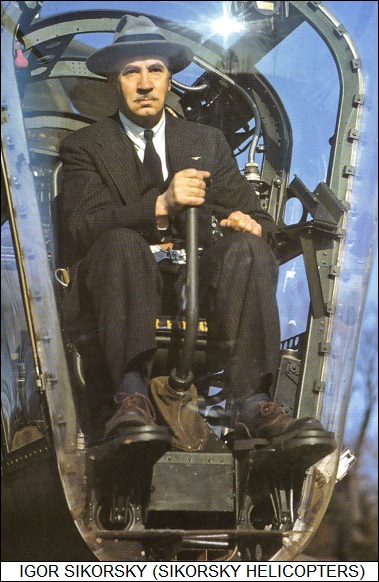
* Focke, Flettner, and some of the other German inventors had made workable helicopters, but Igor Sikorsky would be the first to actually make a real success of the thing.
Following his frustrated experiments in helicopters before the First World War, Sikorsky turned his attention to fixed-wing aircraft. He built the first multi-engine aircraft, the Sikorsky GRAND, and then went on to the ILYA MUROMETS, a great four-engined luxury passenger airliner that looked like something out of a Jules Verne novel; it was likely no coincidence that Sikorsky was a big fan of Verne's writings. The name was that of a tenth-century folk hero. When the war broke out, Sikorsky built about 79 of these huge aircraft for the Tsarist government.
When the Bolsheviks seized power in 1917, Sikorsky decided he was on the wrong side of the class struggle and fled to France in 1918. Failing to find steady work there, he went to the United States in 1919, inspired by the work of Edison and Ford to seek his fortune in a land where a person with "ideas of value" might have a good chance to succeed. After a few lean years, in 1923 he and a few associates founded the Sikorsky Aero Engineering Corporation on Long Island, New York. He finally achieved success in 1928 with his "S-38" amphibian aircraft, which established the Sikorsky name and associated with amphibians and flying boats that would evolve into the great and elegant ocean-spanning Sikorsky Clippers.
In 1929, Sikorsky moved the Sikorsky Aviation Corporation to Stratford, Connecticut, where the company was soon brought under the umbrella of the giant United Aircraft holding company. Although he spent most of his days working on his seaplanes, he still tinkered with helicopter concepts in his spare time. He patented one of his designs in 1931, and by 1935, his son Sergei was building flying models of his father's helicopters, which Igor would demonstrate to his engineers or the board of United Aircraft, which by that time had become a true corporate conglomerate.
In 1938, United Aircraft, suffering under the prolonged economic Depression, had to shut down production at its Sikorsky division. However, in an amazingly far-sighted and generous action, the company allowed Igor Sikorsky to retain a small development team and work on a low-budget helicopter project. Sikorsky was now effectively out of the fixed-wing aircraft business and into the helicopter business full-time; he said later: "It was a wonderful chance to relive one's life all over again." He claimed the machine would cost $30,000 USD to build. It would cost much more than that, but it would still pay off handsomely, and UA management would consider it a bargain.
* Igor Sikorsky's helicopter concepts were based on a rotorcraft with a single three-bladed main rotor, with a small sideways-mounted tail rotor to cancel torque. The idea was not new -- as mentioned in the previous chapter, Boris Yuriev had tinkered with it in 1912 -- but nobody had got it to work to that time. In fact, some aerodynamic experts believed the idea was completely unworkable.
Igor Sikorsky proved them wrong. On 14 September 1939, his "Vought-Sikorsky 300 (VS-300)" helicopter lifted momentarily off the ground, with Sikorsky himself at the controls, his businessman's trilby hat jammed on his head to keep it from blowing off. The name "Vought-Sikorsky" was the result of the merger of United Aircraft's Vought and Sikorsky divisions, which were both sited at Stratford at the time.
The VS-300 was tethered to the ground in its early flights, but Sikorsky kept tweaking it until it could be controlled, and free flights began in the spring of 1940. The VS-300 originally did not have a fuselage or cockpit, consisting only of a naked framework of steel tubing with a main rotor, a tail rotor, an exposed pilot's seat, a 50 kW (65 HP) Lycoming engine, fixed tricycle landing gear, and the hardware to hold it all together. The machine was re-engined with a 65 kW (90 HP) Lycoming engine in the summer of 1940.
The skeletal arrangement of the machine made it easy to perform tweaky modifications. There was a lot of work to be done. For example, once the VS-300 began free flights, it proved to be able to fly controllably in any direction -- except straight ahead. Sikorsky got so frustrated at this problem that he even considered reversing the seat arrangement and leaving it at that, but he eventually realized that in forward flight the downwash from the main rotor system was blanking out the effect of the tail rotor system, indicating a need for adjustments.
The machine was also difficult to handle, leading to a number of accidents -- most seriously a crash on 14 October 1940 that damaged the machine, though Sikorsky was unhurt. In fact, at that time the VS-300 wasn't flying much better than the Breguet-Dorand Gyroplane ever did. Sikorsky was patient and persistent, methodically working through the problems; the mechanics grew so weary of making little changes to the machine that they called it "Igor's Nightmare".
By the spring of 1941, the VS-300 was finally outflying any other helicopter built to that time. It was re-engined again with a 75 kW (100 HP) Lycoming engine and in principle redesignated "VS-300A", but everyone still called it the "VS-300". Tweaks continued, with the machine fitted with a simple fuselage in October 1941. By the end of 1941, the VS-300 was flying so well that it was clear Sikorsky had the technology to build a production machine.
Many of the changes during the development process had been to the tail rotor configuration. Sikorsky started out with a single tail rotor, went to two and even three tail rotors, and then back to a single tail rotor again. Multiple tail rotors had been adopted because Sikorsky had encountered problems with cyclic pitch control early on and had deleted it for a while; that meant fitting multiple tail rotors to counteract torque and also provide directional control. However, Sikorsky managed to get cyclic pitch control working, and the additional tail rotors became redundant.
The tail rotor in a modern helicopter not only counteracts the torque of the main rotor, it also allows the pilot to pivot the aircraft around, using a pair of foot pedals to change the collective pitch of the tail rotor, increasing or decreasing sideways thrust to turn the helicopter in one direction or another. The combination of cyclic stick, collective stick, and twin pedals was confusing for pilots trained with fixed-wing aircraft. Even the famous aviator Charles Lindbergh had troubles when he later took the controls of the VS-300, claiming it made him feel completely out of his profession. He slept on it overnight and then got the hang of it. The VS-300 was finally donated to the Edison Institute Museum in Dearborn, Michigan, in October 1943.
* While Sikorsky was refining the VS-300, in April 1940 the US Army Air Corps (USAAC) had issued a request for proposals for an experimental helicopter. Sikorsky submitted a derivative of the VS-300, but a design from the Platt-LePage Aircraft Company won the competition in July 1940.
W. Lawrence LePage had worked for Harold Pitcairn on gryoplanes, and had been impressed by the German Fa 61. He wanted to build his own helicopter along the same lines as the Fa 61, and he joined up with another engineer, Havilland H. Platt, to form Platt-LePage. The USAAC signed a contract with the Platt-LePage company to build a helicopter designated the "Experimental Rotorcraft 1 (XR-1)". The result was a machine that resembled a smaller version of the Fa 223 Drache, with contra-rotating rotors mounted on outriggers on each side of the aircraft. In fact, LePage had discussed the possibility of license-building the "Fa 224" -- a two-seat refinement of the Focke Model 61 that never actually flew -- with the Focke-Achgelis company, but the outbreak of war put a stop to that exercise.
The XR-1 was powered by a Pratt & Whitney R-985 radial engine with 330 kW (440 HP), had a loaded weight of 2,150 kilograms (4,730 pounds), and had rotors 9.3 meters (30 feet 6 inches) in diameter. The Army selected the Platt-LePage design mostly because it was based on a configuration that was known to work. However, the Army wasn't committed to the Platt-LePage XR-1 to the exclusion of other designs. In July 1940, Captain Frank Gregory, in charge of the USAAC's helicopter effort, visited the Sikorsky plant and took a trial flight at the controls of the VS-300 on July 24. Gregory initially felt that the helicopter handled "like a bucking bronco", but after some further instruction by Sikorsky, Gregory managed to fly the VS-300 successfully, and was impressed by it.
On 10 January 1941, the Army Air Corps awarded Sikorsky a contract to develop a prototype of an operational helicopter based on the VS-300, but substantially bigger, with the designation of "XR-4". That was a big vote of confidence in Sikorsky, since he still hadn't worked all the bugs out of the VS-300.
The Platt-LePage XR-1 performed its first flight in May 1941, but by the end of 1941 the VS-300 was clearly the leader of the pack and Platt-LePage never caught back up, though an improved "XR-1A" was flown. Just before the end of the war, the Army canceled contracts with Platt-LePage, and the company soon folded. Interestingly, Platt-LePage proposed a version of their XR-1 helicopter that mounted four machine guns to the US military. This was probably the first time anyone had formally suggested the concept of a dedicated helicopter "gunship", but the idea was much too far ahead of its time. Helicopters would not be rugged enough to engage in shooting matches for decades, and the military wasn't interested for the time being.
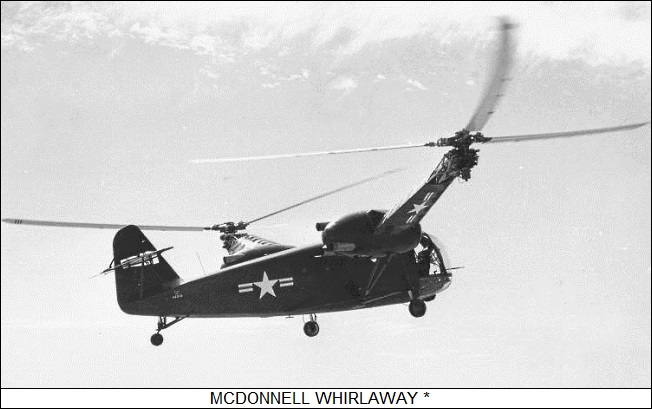
Also interestingly, Platt-Lepage's efforts didn't die out right away. The McDonnell Aircraft Corporation of Saint Louis had acquired half of Platt-Lepage, and when Platt-Lepage folded McDonnell acquired the rest of the venture. McDonnell had been conducting work on their own helicopter design, also along the lines of the Focke-Achgelis machines, and leveraging off Platt-LePage expertise built it as the "XHJD-1 Whirlaway". It looked much like a scaled-up XR-1 with twin P&W R-985 Wasp Junior engines. McDonnell tried to sell it to the Navy, but the Navy wasn't impressed and withdrew support. That was the end of that, though McDonnell did tinker with various designs for "tipjet" helicopters into the early 1950s.
BACK_TO_TOP* The VS-300 was the first successful American helicopter, and its configuration was the basis for the majority of future helicopter designs, though coaxial, fore-and-aft contra-rotating, and eggbeater designs are still being successfully built and operated.
Sikorsky would become the most famous of the helicopter pioneers, leading to a widespread myth that he was actually the inventor of the helicopter himself, which he was always careful to deny. However, he did become a father figure for the industry, not merely for his pioneering efforts but because of his reputation for extreme competence as a manager, designer, and even pilot; his sensibility; and his understated old-world civility.
The XR-4 prototype that the Army had ordered in early 1941, with the company designation of "VS-316A", first flew on 14 January 1942. It was about twice the size of the VS-300, with a 125 kW (165 HP), seven-cylinder Warner R-500 Super Scarab radial engine; side-by-side seating for two; and a boxy cloth-covered tube-frame fuselage with plexiglas windows. The XR-4 design had originally featured triple tail rotors, but the single tail rotor system was working and in place by the time of the first flight. This machine would eventually end up in the hands of the Smithsonian National Air & Space Museum in Washington DC.
In December 1942, the Army Air Forces (USAAF, which had superseded the Air Corps in June 1941) ordered a batch of three "YR-4As" for evaluation, and shortly after that 27 "YR-4Bs" for service tests. These machines were much like the XR-4, but had a 135 kW (180 HP) Super Scarab engine and a wider rotor. Three of the YR-4Bs went to the US Navy and were evaluated under the designation "HNS-1". During this time, at the beginning of 1943, Sikorsky moved production to a disused factory in Bridgeport, Connecticut, since the Stratford plant was running at capacity building Vought F4U Corsair fighters. That ended the "Vought-Sikorsky" relationship, and the helicopters would strictly be "Sikorskys" from then on.
The YR-4A/Bs were followed by a hundred production "R-4Bs" with a 150 kW (200 HP) engine, which were the first American helicopters to reach operational service. 35 of this batch went to the USAAF; 20 went to the US Navy as HNS-1s; a few went to the Coast Guard; and 45 went to Britain, where the type was designated "Hoverfly I" and used by the British Royal Air Force (RAF) and Royal Navy's Fleet Air Arm (FAA). Ironically, the British had actually ordered the R-4Bs, asking Sikorsky to build 150, but then the helicopter bandwagon got rolling and the US armed forces pulled priority on the British to take the R-4Bs themselves. The British were last in line for the helicopters, but it didn't matter too much, since their requirements had changed in the meantime, and much more suitable machines than the R-4 were on the way anyway.
The XR-4 suffered from excessive vibration, with the problem persisting in the evaluation and production machines. That turned out to be due to maddeningly subtle differences in the internal weight distribution of the rotor blades. The Sikorsky company implemented much more careful production procedures; insisted on blades being sorted into matched sets of three, with an entire set replaced if one blade were damaged; and also developed an adjustment mechanism in the rotor head to allow "calibration" of the rotor system in the field. These were strictly stopgap measures, and company engineers set to figuring out a real fix for the long term.
In short, the R-4 was still not quite ready for serious field use, all the more so because it was very limited in performance and payload, particularly on hot days. One flight demonstration for USAAF brass of a YR-4A on a hot, windless day in the summer of 1942 at Wright Field in Ohio ended in embarrassment when the machine simply refused to leave the ground.
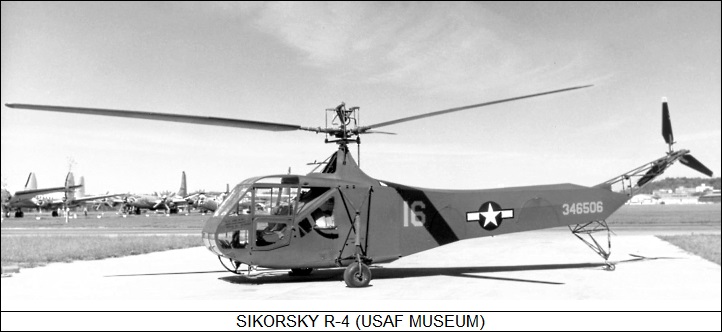
However, despite its limitations, the R-4 quickly demonstrated the value of the helicopter, performing a number of rescues and emergency deliveries under field conditions in the last year of the war. It was the first helicopter to land on a ship, when Frank Gregory put one down on the tanker BUNKER HILL on 6 May 1943, and it could be fitted with pontoons for water landings. The R-4's service life was short-lived, but it did serve to train the first generation of American and British military helicopter pilots, and gave the military some good ideas on what might be done with more capable machines.
___________________________________________________________________
SIKORSKY R-4B:
___________________________________________________________________
rotor width:
11.6 meters (38 feet)
fuselage length:
10.8 meters (35 feet 5 inches)
height:
3.78 meters (12 feet 5 inches)
empty weight:
916 kilograms (2,020 pounds)
max loaded weight:
1,150 kilograms (2,535 pounds)
maximum speed:
132 KPH (82 MPH / 71 KT)
service ceiling:
2,440 meters (8,000 feet)
range:
209 kilometers (130 MI / 113 NMI)
___________________________________________________________________
* The R-4 led to the similar but refined "VS-316B" or "R-6", which was essentially an R-4 with a more powerful engine plus a much improved fuselage, built of metal, fiberglass, and phenolic-impregnated paper. The prototype "XR-6", powered by a vertically-mounted 170 kW (225 HP) Franklin engine, with development initiated in January 1943. First flight was on 15 October 1943.
Five trials "XR-6As" with a 180 kW (240 HP) Franklin engine were built by Sikorsky, and 26 similar "YR-6As" were built by the Nash-Kelvinator company. Nash Kelvinator also built 193 production "R-6As", beginning in 1945, with 36 going to the US Navy as the "HOS-1" and 40 going to the British RAF as the "Hoverfly II". Like the R-4, the R-6 could be fitted with pontoons, and like the R-4, the R-6's service life was short, particularly because its engine proved unreliable.
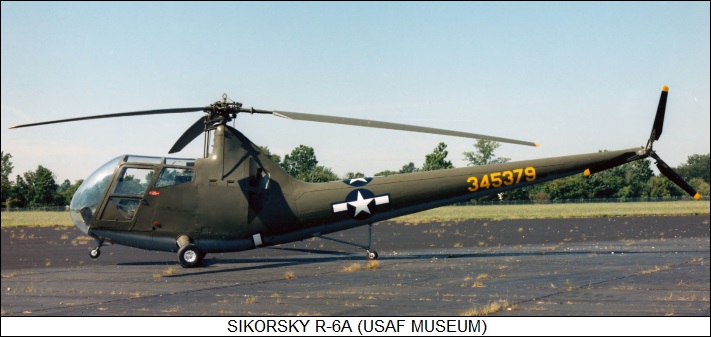
* When Sikorsky committed to development of the R-6, the company also committed to development of a substantially more capable helicopter, the "R-5" or "VS-337". It was originally conceived in response to a British request for a helicopter suitable for anti-submarine warfare, with good visibility and the capability to carry depth charges. The USAAF was interested and ordered five prototype and evaluation machines, along with the order for YR-4s placed in December 1942.
The R-5 was a tandem-seat helicopter with a 335 kW (450 HP) Pratt & Whitney R-985-AN-5 Wasp Junior air-cooled radial engine, a larger rotor, a "greenhouse" cockpit to improve field of view, and all-metal construction. The fuselage featured rounded corners -- the R-4's boxy shape had disrupted rotor downdraft -- and had a taildragger landing gear configuration. Initial flight of the prototype "XR-5" was on 18 August 1943.
Just as the scale-up from the VS-300 to the R-4 had led to vibration problems, the next scale-up to the R-5 led to a new set of very nasty vibration problems that proved difficult to iron out. However, the military really wanted helicopters immediately, and despite the problems the USAAF followed up the initial order for five with an order for 26 "YR-5As" (later designated "YH-5A") for evaluation. This order was followed in turn by another order for 100 production "R-5A" (later "H-5A") machines, though only 34 of this version were built. The R-5A had provisions for carrying a stretcher on each side of the cockpit.
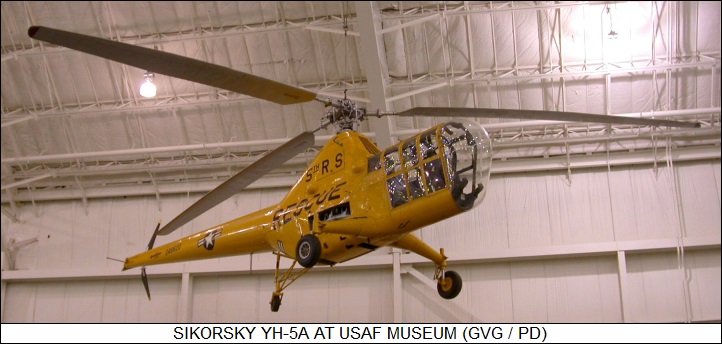
21 R-5As were modified with a third seat, auxiliary fuel tank, tricycle-style landing gear, and a rescue hoist, to be given the new designation of "R-5D" (later "H-5D"). Three of this batch were evaluated by the US Navy as the "HO2S-1". Five of the evaluation YR-5As were also given dual controls and used for training as "YR-5Es" (later "YH-5E").
___________________________________________________________________
SIKORSKY R-5A:
___________________________________________________________________
rotor diameter:
14.63 meters (48 feet)
length:
17.4 meters (57 feet 1 inch)
height:
3.96 meters (13 feet)
empty weight:
1,715 kilograms (3,780 pounds)
max loaded weight:
2,190 kilograms (4,825 pounds)
maximum speed:
170 KPH (105 MPH / 90 KT)
service ceiling:
4,390 meters (14,400 feet)
range:
580 kilometers (360 MI / 313 NMI)
___________________________________________________________________
Although there were massive cutbacks in aircraft orders at the end of the war, in compensation the pressure for immediately delivery of machines was off, and Sikorsky set out on a comprehensive redesign of the R-5 to finally get rid of the bugs.
The result was the "S-51", with four seats instead of two. It was one of the first helicopters honestly suitable for operational use. Initial flight was on 16 February 1946. With military sales slow, Sikorsky tried to sell the type commercially, but though a few were bought by airlines, it was an expensive, somewhat dubious toy and was not a commercial success. Sikorsky turned back to the military, and pitched it to the Navy. The Navy was impressed, and bought 90 S-51s as the "HO3S-1" to rescue pilots who had gone into the sea after carrier landing or take-off accidents, and the Air Force obtained 11 of the type as the "H-5D".
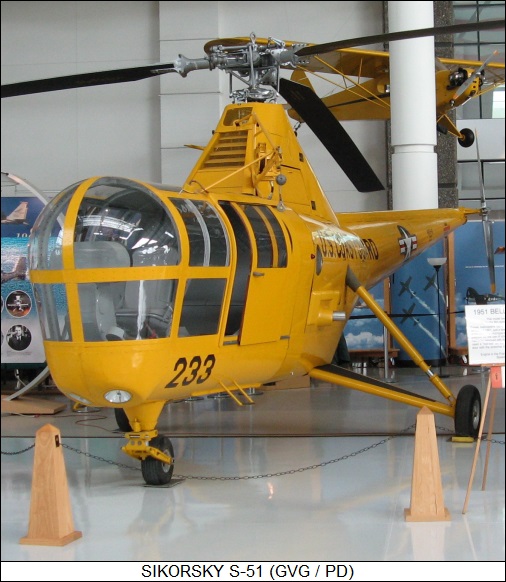
Some S-51s were built with 450 kW (600 HP) engines and wider rotors, and the rotor blades could be folded back for storage. A further batch of 39 S-51s with improved rescue gear were sold as the "H-5G", while 16 "H-5H" helicopters were delivered in 1949 with pontoon / wheel landing gear. Total production quantity of the S-51 is unclear, but was about 300.
* The S-51 was a big improvement over the R-4, but the Sikorsky company saw it as possibly too big and expensive to sell to the civilian market, and so Sikorsky decided to develop a intermediate-sized helicopter, the two-seat "S-52", which first flew in 1947. It featured a 130 kW (180 HP) Franklin engine, as well as metal rotor blades, which Sikorsky adopted because the wooden blades of previous machines had proven so hard to balance.
Although the S-52 was regarded as a very sophisticated design, by that time Sikorsky had competition in the helicopter business and nobody bought it. However, the type was regarded as promising by the military, and Sikorsky developed a four-seat variant, the "S-52-2", with a 180 kW (245 HP) Franklin engine. The US Army evaluated the type as the "H-18", but did not purchase it in quantity, though a total of 89 served with the US Marines as the "HO5S-1" and the Coast Guard as the "HO5S-1G". It was not a particularly impressive machine even by the standards of the time, with poor performance and reliability.
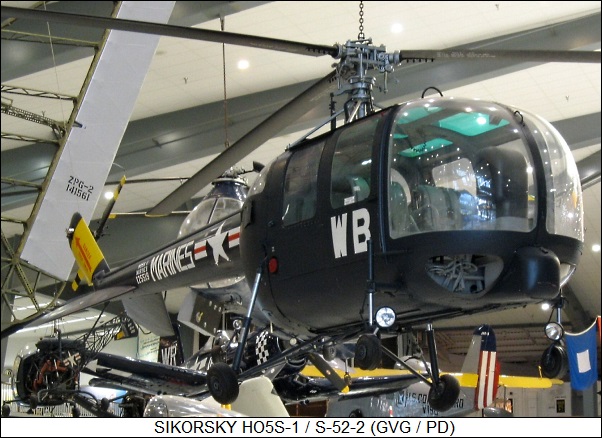
In the interim between the S-52 and S-52-2, Sikorsky also developed a five-seat helicopter, the "S-53", a follow-on to the S-51 designed for a US Navy competition. The S-53 first flew in 1948, and had a 375 kW (500 HP) Continental R-975 engine, plus metal folding rotor blades. The Navy evaluated it in 1949 as the "XHJS-1", but it proved so inferior to other entrants in the competition that Sikorsky all but suppressed any mention of the type from that time on. Only three prototypes were built.
BACK_TO_TOP* In fact, other American helicopter pioneers, including Stanley Hiller, Arthur Young (of Bell Aircraft), Frank Piasecki, and Charles Kaman had developed their own helicopters that were a match or more for Sikorsky's products, and put them into production. In the Korean War, although Sikorsky's S-51 put in noteworthy service, it was overshadowed in the utility and medevac roles by the Hiller 360 / OH-23 Raven and particularly by the Bell Model 47 / H-13 Sioux, the famous "MASH" medevac helicopter. Piasecki, who developed a line of distinctive tandem-rotor helicopters, also handed the Sikorsky S-53 a humiliating beating in a Navy competition with what would become the Piasecki HUP helicopter.
The stories of Piasecki, Bell Helicopters, Hiller, and Kaman are complicated enough to deserve detailed discussions elsewhere. Sikorsky might have joined the ranks of other pioneers, like the Wright Brothers, who could get the ball rolling but couldn't stay with it over the long run. However, Igor Sikorsky was no push-over. He learned from his mistakes and Sikorsky would remain a power in helicopters to the present day, but that is also another story.
Other American companies that jumped into the helicopter field in the postwar period but couldn't keep up. Literally hundreds of companies were formed to build helicopters in the late 1940s. Only a fraction of them ever actually flew machines, and only a handful of them managed to make a business out of it.
The Kellett and Pitcairn gyroplane companies were among those who fell by the wayside; they waited too long to get into helicopters and couldn't catch up with the competition. Late in the war, Kellett developed a helicopter, the "XR-8", using USAAF funds. It was an "eggbeater" machine like the Flettner Fl 282, with a fuselage resembling that of a flea. The Army was impressed enough with the XR-8 to issue a follow-on contract for a scaled-up version, the twin-engine XR-10, which performed its first flight in 1947. It suffered a fatal crash, which led to the cancellation of the program in 1948. Kellett had procrastinated too long to get in on the helicopter business and could not catch up. The company sold off their work on an oversized flying-crane helicopter to Hughes, who developed it as the "XH-17". Hughes tried to sell it to the US Air Force in the early 1950s, but the USAF wasn't interested.
The Pitcairn company had undergone a series of reorganizations beginning in 1940, to finally be bought up by Firestone in 1943. As the Firestone G&A Division, the organization developed a two-seat helicopter designated the "XR-9", which was evaluated by the USAAF in 1946. The Army didn't buy off on it, and showed no real interest in its larger successor, the "XR-14". Firestone tried to sell the XR-14 on the private market, but with no success, and the company decided to stick with making tires.
* In Europe, helicopter companies sprang up as well, led by Westland in the UK. Westland had an advantage in having a relationship with Sikorsky, initially obtaining a license for the S-51. The first "Westland-Sikorsky WS-51" performed its initial flight on 5 December 1948, and led to a production batch of "Dragonfly Helicopter Rescue Mark 1 (HR.1)" machines for the Royal Navy FAA, with an Alvis Leonides 50 radial engine providing 400 kW (540 HP).
The Dragonfly HR.1 equipped the first operational helicopter squadron in the Royal Navy. The RAF obtained a similar variant with external litters for casualty evacuation as the "Dragonfly HC.2". Addition of an all-metal rotor to these versions led to the FAA "Dragonfly HR.3" and the RAF "Dragonfly HC.4". The FAA also obtained a final version with minor improvements over the HR.3, designated the "Dragonfly HR.5".
Westland sold commercial versions as well, including the "WS-51 Mark 1A", with an Alvis Leonides 521/1 engine with 390 kW (520 HP) , and the "WS-51 Mark 1B", which was similar to the Mark 1A but had a Pratt & Whitney R-985-B4 Wasp Junior radial engine with 335 kW (450 HP). These machines were sold in small numbers to commercial operators, as well as Japanese, Italian, and Thai military services. About 150 Dragonfly / WS-51 machines were sold in all.
The company also produced a derivative of the R-5 in the mid-1950s known as the "Widgeon", which featured a new automobile-style fuselage with seating for four passengers plus the pilot, an Alvis Leonides 521/1 engine, and the improved rotor of the bigger Sikorsky "S-55" helicopter, to be discussed elsewhere. A total of 14 Widgeons was built, some of them (including the prototype) being conversions of Dragonflies.
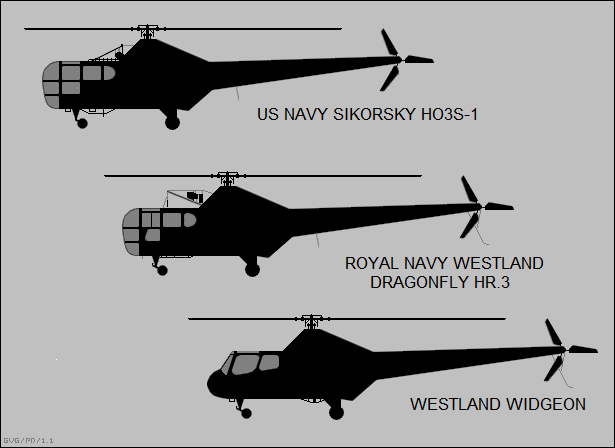
Westland's license construction of the Sikorsky S-51 gave the British firm a head start in helicopter development in the UK that it would never lose, and in fact Westland eventually absorbed all its British competitors. Westland continued their profitable license production of Sikorsky designs, but very often added their own improvements and optimizations, and designed excellent rotorcraft of their own.
Other European companies followed Westland, including Aerospatiale in France, Agusta in Italy, and Messerschmitt-Boelkow-Blohm (MBB) in Germany. The Soviets also worked on their own rotorcraft designs, pioneered by a series of experimental helicopters developed by Ivan Bratukhin. Bratukhin would never build a production helicopter, but two of his contemporaries, Mikhail Mil and Nikolai Kamov, would establish design bureaus that have survived to this day and produce large numbers of helicopters.
* From these beginnings, the helicopter proved its value in peace and war. The technology would be improved, with turbine powerplants largely replacing piston engines in the 1960s. The helicopter continues to be refined and even reinvented. After decades of development work, tilt-rotor aircraft are now starting to enter operation, where they provide performance similar to that of a turboprop fixed-wing aircraft and the vertical take-off capabilities of the helicopter. In the 21st century, the helicopter can look forward to new achievements.
BACK_TO_TOP* This document began as a set of notes from the US History Channel's MODERN MARVELS TV series on the origins of the helicopter and its evolution to the present day. Other sources include:
* Revision history:
v1.0 / 01 feb 01 v1.0.1 / 01 aug 02 / Review & polish. v1.1.0 / 01 sep 04 / Split into two chapters. v1.1.1 / 01 oct 04 / Minor tweaks. v1.1.2 / 01 sep 05 / More minor tweaks. v1.1.3 / 01 aug 07 / Review & polish. v1.1.4 / 01 jul 09 / Review & polish. v1.1.5 / 01 jun 11 / Review & polish. v1.1.6 / 01 apr 13 / Review & polish. v1.1.7 / 01 apr 15 / Review & polish. v1.1.8 / 01 mar 17 / Review & polish. v1.1.9 / 01 feb 19 / Review & polish. v1.2.0 / 01 dec 20 / Review & polish. v1.2.1 / 01 oct 22 / Review & polish. v1.2.2 / 01 aug 24 / Review & polish. (+)BACK_TO_TOP
